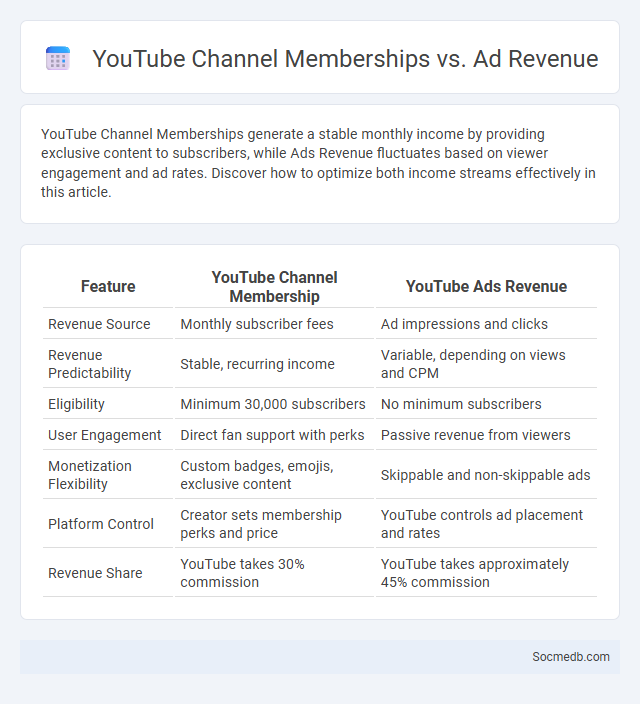
Photo illustration: YouTube Channel Membership vs Ads Revenue
YouTube Channel Memberships generate a stable monthly income by providing exclusive content to subscribers, while Ads Revenue fluctuates based on viewer engagement and ad rates. Discover how to optimize both income streams effectively in this article.
Table of Comparison
| Feature | YouTube Channel Membership | YouTube Ads Revenue |
|---|---|---|
| Revenue Source | Monthly subscriber fees | Ad impressions and clicks |
| Revenue Predictability | Stable, recurring income | Variable, depending on views and CPM |
| Eligibility | Minimum 30,000 subscribers | No minimum subscribers |
| User Engagement | Direct fan support with perks | Passive revenue from viewers |
| Monetization Flexibility | Custom badges, emojis, exclusive content | Skippable and non-skippable ads |
| Platform Control | Creator sets membership perks and price | YouTube controls ad placement and rates |
| Revenue Share | YouTube takes 30% commission | YouTube takes approximately 45% commission |
Understanding YouTube Monetization: An Overview
YouTube monetization enables content creators to earn revenue through ads, channel memberships, Super Chats, and YouTube Premium revenue. Eligibility requires meeting the YouTube Partner Program criteria, including 1,000 subscribers and 4,000 watch hours in the past 12 months. Understanding YouTube's monetization policies and audience engagement metrics is essential for maximizing earnings and sustaining long-term channel growth.
What is YouTube Channel Membership?
YouTube Channel Membership allows creators to offer exclusive perks to subscribers who pay a monthly fee, such as badges, emojis, and access to members-only content. This feature helps creators generate consistent revenue while building a loyal community. Members receive special engagement opportunities like live chats and early video access, enhancing their connection to the channel.
How YouTube Ads Revenue Works
YouTube Ads revenue is generated through a pay-per-click or pay-per-impression model, where advertisers bid to display their ads on videos relevant to their target audience. Content creators earn a share of this revenue based on factors like watch time, viewer engagement, and ad formats such as skippable video ads, display ads, and bumper ads. Your earnings depend largely on the number of monetized views and the geographic location of your audience, with higher CPM rates in countries like the United States and Canada.
Channel Membership vs Ads Revenue: Key Differences
Channel Membership offers creators a stable monthly income through subscriber fees, fostering a loyal community with exclusive content and perks. Ads Revenue depends on view counts and ad engagement, providing variable earnings influenced by algorithmic factors and advertiser demand. While Channel Membership emphasizes direct fan support, Ads Revenue relies heavily on content reach and viewer retention metrics.
Revenue Potential: Which Monetization Method Pays More?
Social media platforms generate significant revenue through diverse monetization methods such as advertising, influencer partnerships, and subscription models. Advertising, particularly targeted ads on platforms like Facebook and Instagram, tends to offer the highest revenue potential due to vast user engagement and precise data-driven audience targeting. Influencer marketing also yields substantial income streams, especially when combined with brand sponsorships and affiliate marketing, though subscription-based models like Patreon or exclusive content channels provide steady, albeit generally lower, revenue compared to ad-driven approaches.
Audience Engagement: Memberships vs Ad-Driven Channels
Membership-based social media channels foster deeper audience engagement by offering exclusive content, personalized interactions, and a sense of community, which drives loyalty and higher retention rates. In contrast, ad-driven channels rely on broad reach and frequent content updates to capture attention but often face challenges with user trust and engagement consistency due to intrusive advertising. Data shows membership models yield higher average watch times and conversion rates, emphasizing the growing preference for quality engagement over sheer volume in social media marketing strategies.
Eligibility Requirements for Monetization Features
To qualify for social media monetization features, you must meet specific eligibility requirements such as a minimum follower count, consistent content engagement, and compliance with platform policies. You typically need to have a creator or business account, a set number of watch hours or views within a defined period, and adhere to community guidelines to maintain access to monetization tools. Platforms often require you to be in a supported region and enable two-factor authentication for account security before approving monetization features.
Best Practices for Maximizing Membership and Ad Revenue
Consistently posting engaging content tailored to your audience's interests boosts membership growth and increases ad revenue by attracting higher traffic. Utilizing data analytics helps you optimize posting times, content formats, and ad placements to maximize user interaction and monetization. You should also encourage community participation through interactive features like polls or live videos to foster loyalty and improve your platform's value to advertisers.
Pros and Cons: Channel Memberships and Ads Revenue
Channel memberships offer a reliable revenue stream by allowing creators to earn recurring income through subscriber perks, enhancing audience loyalty and engagement. However, they require consistent content updates and can alienate non-paying viewers, potentially limiting channel growth. Ads revenue provides passive income accessible to all creators, but fluctuates with viewer demographics and platform policies, often yielding inconsistent financial support.
Choosing the Right Monetization Strategy for Your Channel
Selecting the ideal monetization strategy for your social media channel hinges on audience demographics, engagement rates, and content niche. Tailoring approaches such as affiliate marketing, sponsored posts, or subscription models maximizes revenue potential while maintaining authenticity. Analyzing platform-specific algorithms and user behavior data ensures sustainable income growth and channel longevity.
 socmedb.com
socmedb.com